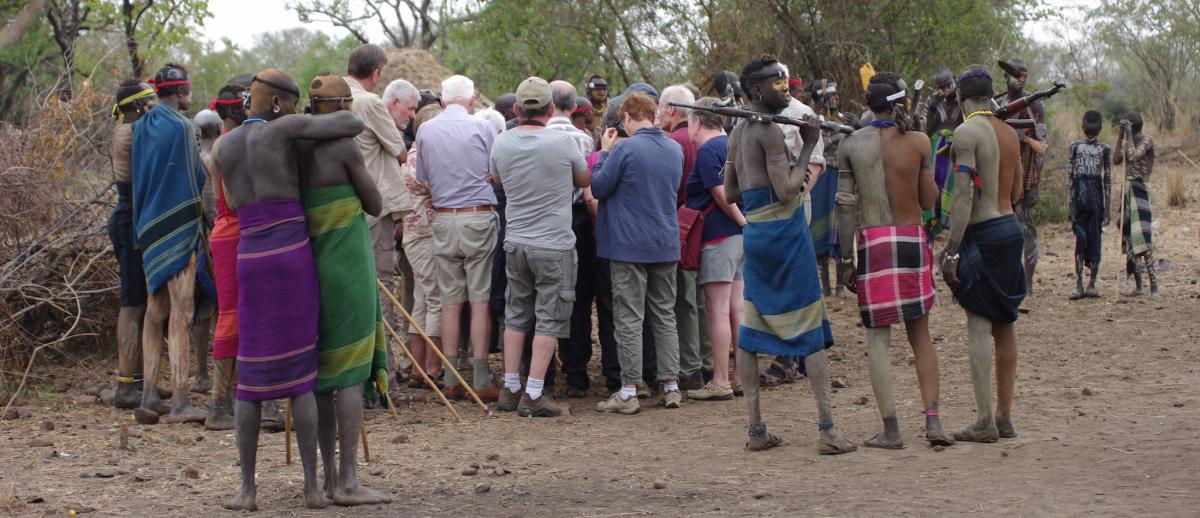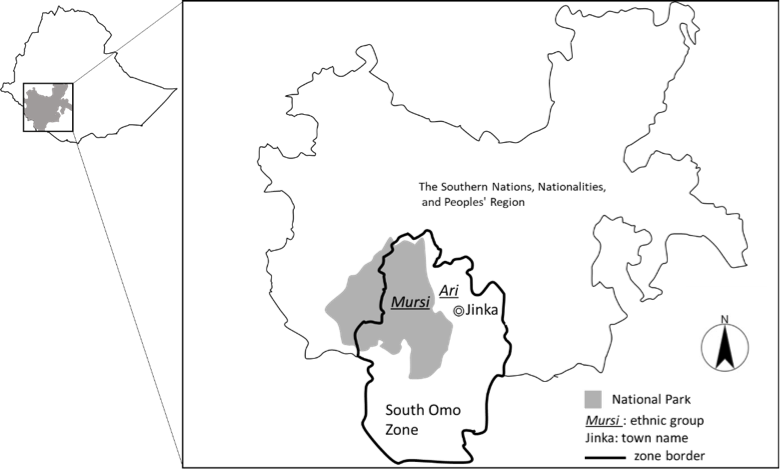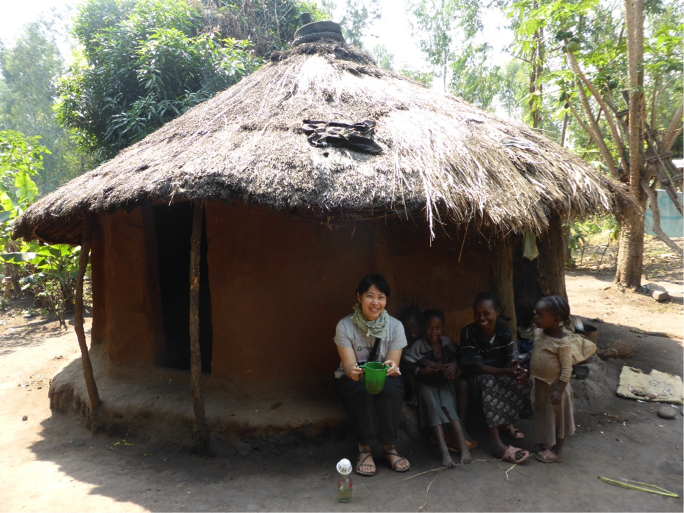An Ethiopian Alternative to “Traditional” Ethnic Tourism
archive


Figure 2: visitors in a Mursi tourist village (photo: Nobuko Nishizaki)
An Ethiopian Alternative to “Traditional” Ethnic Tourism
Tourism has been growing rapidly in Ethiopia. According to IMF estimates, Ethiopia averaged annual growth rates of 10.8% between 2004 and 2014, as measured by GDP per capita.1 Since the mid-2000s, the Ethiopian federal government has promoted tourism as another form of economic development. It started to develop infrastructure and services for well-managed tourism that offers manifold experiences and a safe stay for foreign visitors, as well as job opportunities for local communities. As a result, the government has urged large numbers of tourists to visit some of the country’s most remote areas. Wildlife viewing tours (safaris) are still unpopular in Ethiopia, but historical and heritage tourism in the north, and ethnic tourism in the southwest, is rapidly growing.
In this essay I discuss how local communities in southwest Ethiopia negotiate the various, contrasting external representations of their “unchanged” cultures by focusing on the case of the Ari, the largest community in the South Omo Zone. My observations are based on fifteen years of anthropological research in the South Omo Zone and provide a window onto a successful, locally controlled, and ‘bottom up’ development initiative succeeding in the face of erosive global forces.
“Traditional” culture as tourist commodity
Ethnic tourism is particularly popular in the South Omo Zone in the Southern Nations, Nationalities, and Peoples' Region (SNNPR) (see Figure1). The “tribal south” is a symbolic phrase used by tour operators to explain this area’s ethnic tourism. Some guidebooks emphasize the area’s “wilderness,” “primitiveness,” and “original culture” by focusing on the agro-pastoral society, and consequently the majority of international tourists expect to encounter an “unchanged” culture. Yet ethnic tourism developed alongside government construction of a hydroelectric dam on the Omo River and the establishment of commercial agricultural plantations. In the 2000s, a trunk road connecting the capital city Addis Ababa and the town of Jinka was built, as were transport roads for plantations along with several new lodging establishments in the town. This improved infrastructure enabled the area to become a major tourist destination, and the number of tourists in South Omo Zone increased sharply from 3,879 in 2004 to 33,100 in 2013.2

Figure 1. Research area
The Ethiopian federal government has mixed feelings about the growth in ethnic tourism in the region. Pastoralism is viewed as backward, uneconomical, and in need of modern development. The government also sees the grazing land used by agro-pastoralists as under-utilized “no-man’s land” and has been converting it into commercial agricultural parcels funded by public or private entities.
From the government’s perspective, abandoning traditional livelihoods based on pastoralism in favor of modern agriculture will help spur regional development. Thus for policymakers the marketing of “undeveloped” areas to satisfy tourists’ expectations is not desirable. For this reason, the Ethiopian government has not been a keen supporter of alternative tourism projects, including community-based tourism (CBT), which have tended to rely on the representation of pastoral lifestyles in southwest Ethiopia for tourist consumption.
Although guides are playing a major role interpreting traditional culture for tourists, and the government of Ethiopia is trying to increase the number of qualified local guides by supporting the establishment of guide associations in rural areas, there are not enough local guides in this agro-pastoral society. For example, the Mursi community, with a population of about 7,000, is the most visited in the region, where women with lip plates and men with flamboyantly decorated bodies have long attracted tourists (see Figure 2). Yet there are few Mursi guides, so that guides from other ethnic backgrounds from the capital or from the town of Jinka explain the Mursi society and culture, but often offer stereotyped accounts of an “isolated nomadic tribe.” They emphasize static “traditional” culture.3 The government, guests, and guides perceive and represent the local society as an “unchanged culture.”
[T]he Ethiopian government has not been a keen supporter of alternative tourism projects... which have tended to rely on the representation of pastoral lifestyles in southwest Ethiopia for tourist consumption.
The Ari as newcomers to ethnic tourism
An alternative approach can be found in the lowlands of the South Omo Zone where the Ari people are largely dependent on agricultural activities, cultivating ensete (Ensete ventricosum, commonly known as “false banana,” the region’s most important root crop), as well as taro, yams, maize, barley, wheat, and teff (Ethiopia's indigenous grain). Ari settlements did not become destinations until the number of tourists visiting remote Mursi villages sharply rose. Consequently the Ari are recent entrants into the ethnic tourism business.
In Ari villages, everyday life is treated as a tourism resource. Tourists walk through the village with a local Ari guide, who tells them the local names and characteristics of fruits such as bananas, mangos, grains, ensete, yams, pumpkins, cassavas, and some local spices. Tourists are invited to try their hand at cooking these foods and taste them on-site. Guides also explain how the local beer is brewed, and the village’s main attraction is an artisanal workplace where tourists can watch professional blacksmiths and potters at work (see Figures 3 and 4). Dances and songs are another typical attraction of ethnic tourism, but they are only performed for visitors during the harvest season, a traditional time for these activities.

Figure 3. Village tour in an Ari settlement (photo: Nobuko Nishizaki)
Village K (population of about 3,500) has been most active in tourism. Initially, ten young Ari men established a guide association called the NegeSewi Local Guide Association in 2010.4 The Ari guides participate in almost every phase of the tourism encounter such as arranging visitor logistics with tour companies, collecting entrance fees, and paying villagers who provide services. Each guide has their preferred tour route and arranges which sites will be visited. Guides negotiate in advance with villagers to accept tourist guests, as local food and beer are prepared for them to sample. Guides also are the key transcultural interface, offering foreigners basic explanations about Ari society and culture.
Tourist numbers swell from the end of September to March compared to the rest of the year. This high season corresponds with the agricultural off-season, so the guides effectively balance the agricultural and tourism seasons.
The Ari perceive tourism mainly as a cash-generating resource, with half the entrance fee divided among those who are involved in the tour and the other half saved for the future. Presently, villagers are closely connected with the guides and are benefiting from them economically. In an interview with an Ari guide in January 2015, I was told that they are very happy to have a chance to engage in tourism. In the past, especially in dry seasons, they spent the time idly in their houses.
The Ari perceive tourism mainly as a cash-generating resource, with half the entrance fee divided among those who are involved in the tour and the other half saved for the future.
Tourism has therefore become an extension of the villagers’ daily lives. Local people are moderately involved in the tourism business, but they spend most of their time on agriculture, blacksmithing, and making pottery. Nobody considers themselves completely devoted to tourism, and indeed, locals have not even tried making souvenirs. Since visits by foreigners are still a new phenomenon in the area, it is not yet a highly competitive livelihood. Therefore, the business of guiding, which requires only a small investment, can provide a new means of subsistence and is an attractive occupation, especially for young people.

Figure 4: an Ari blacksmith's workplace is a popular tourist stop (photo: Nobuko Nishizaki)
Local Initiatives in Ethnic tourism
Ari tourism is an example of a bottom-up tourism initiative. The Ari guide association is a key stakeholder in the control of the local tourism business, but it cooperates with villagers so that everyone earns relatively generous cash income from tourism while at the same time maintaining a distinctive perspective on their “traditional” culture that emphasizes rich agricultural landscapes, local hospitality, and the rhythms of everyday life. Although most tourists seem satisfied with these features, others commented, “we were extremely disappointed when they were wearing the same clothes as us.” Thus there are gaps between the hosts’ lifestyles and some guests’ expectation that the area would be “backward.” However, this tension is in fact valuable since it helps create new tourism experiences and expectations. Even as the government and some scholars criticize the area’s increasingly global tourism business, the villagers seem able to engage with it on their own terms, and to largely control what tourism brings to their community.
1. IMF (2017) World Economic Outlook Databases (last accessed on 30 June 2018):
(https://www.imf.org/external/pubs/ft/weo/2017/01/weodata/index.aspx)
2. South Omo Zone Tourism and Cultural Office (2013) Tourism statistics in South Omo (2004-2013), South Omo Zone Tourism and Cultural Office, Ethiopia.
3. Turton, D. (2004) “Lip-plates and ‘the people who take photographs’: Uneasy encounters between Mursi and tourists in southern Ethiopia.” Anthropology Today, Vol. 20 (3): 3-8.
4. This means ‘tomorrow's person’ in Amharic.



